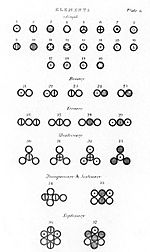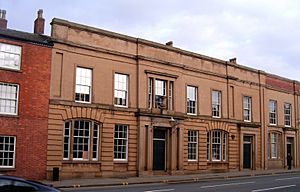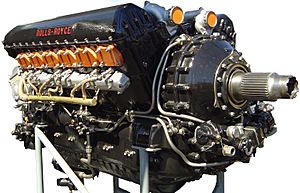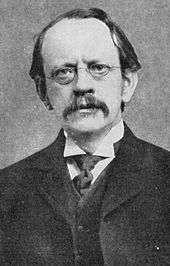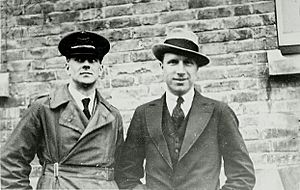Science and technology in Manchester facts for kids
Manchester is a very important city in the United Kingdom. It became a city in 1853. Manchester is often called the first industrial city because it grew a lot during the Industrial Revolution. In 1717, about 10,000 people lived there, but by 1911, this number had grown to 2.3 million!
As Manchester grew, it became a hub for new ideas, science, and technology. People often say, "What Manchester does today, the rest of the world does tomorrow." This city saw many firsts, like the first 'true' canal, which started 'Canal Mania'. It also had the first intercity railway station, leading to 'railway mania', and the first stored-program computer.
Manchester has also been very successful in physics. Scientists connected to Manchester discovered the electron (J. J. Thomson, 1897), the proton (Rutherford, 1917), and the neutron (James Chadwick, 1934). Many famous scientists, like John Dalton, James Prescott Joule, and Alan Turing, studied here. The city is home to the University of Manchester, which has 25 Nobel Prize winners! You can also visit the Museum of Science and Industry to see Manchester's amazing achievements.
Contents
17th Century Discoveries
Observing Venus
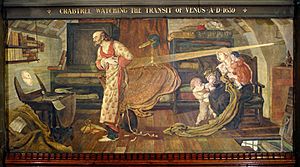
In 1630, an astronomer named William Crabtree made an important observation: he watched the planet Venus pass in front of the Sun. Crabtree was born near Manchester and went to The Manchester Grammar School. He worked as a merchant, but his real passion was astronomy. He carefully measured how planets moved and made very accurate calculations.
Crabtree became friends with another amateur astronomer, Jeremiah Horrocks. They were part of a group called "Nos Keplari," who were the first people in Britain to truly understand the size of our Solar System. In 1639, Crabtree and Horrocks were the only astronomers to see and record the transit of Venus, just as Horrocks had predicted. Their work helped Horrocks figure out the size of Venus and how far Earth is from the Sun.
18th Century Innovations
The First Successful Canal
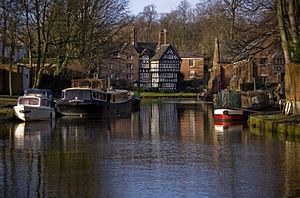
The Bridgewater Canal, which opened in 1761, is known as one of the first truly successful canals. It connects Runcorn, Manchester, and Leigh in North West England. Francis Egerton, 3rd Duke of Bridgewater, built it to move coal from his mines in Worsley to Manchester.
Building the canal cost a lot of money, but it was worth it! Within a year of opening in 1761, the price of coal in Manchester dropped by half. This success inspired a huge period of canal building across Britain, known as 'Canal Mania'. The Bridgewater Canal, with its stone aqueduct at Barton-upon-Irwell, was a major engineering marvel. People at the time said it was "the most extraordinary thing in the Kingdom, if not in Europe."
19th Century Breakthroughs
John Dalton and Atoms
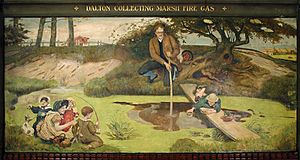
John Dalton moved to Manchester in 1793. He was a brilliant young scientist. Dalton was the first to suggest the idea of "colour blindness" because he experienced it himself. Before him, no one had really talked about it formally.
Dalton also came up with the Dalton atomic theory. He believed that all elements are made of tiny particles called atoms. This idea changed how scientists understood matter forever!
The World's First Intercity Railway Station
The Manchester Liverpool Road railway station opened on September 15, 1830. It was the starting point for the world's first intercity passenger railway, the Liverpool and Manchester Railway. This railway was special because all its trains were pulled by steam locomotives on a set timetable.
This station is the oldest surviving railway terminal in the world. It stopped serving passengers in 1844 but is now preserved by the Museum of Science and Industry.
Joseph Whitworth: Engineering Genius
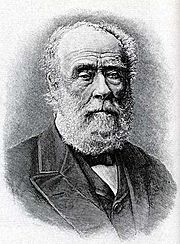
Joseph Whitworth was a talented engineer and inventor from Stockport, near Manchester. He worked in factories in Manchester for many years. In 1841, Whitworth created the first standard screw thread system in the world, known as the British Standard Whitworth. This made it much easier to build and repair machines.
Whitworth also invented the Whitworth rifle. This rifle was a huge step forward in firearm design. It could shoot much farther and more accurately than any other gun at the time. During the American Civil War, soldiers using Whitworth rifles could hit targets from about 800 yards away! This made the Whitworth rifle one of the first, if not the first, sniper rifle. Many places in Manchester are named after him, including Whitworth Street and the Whitworth Art Gallery.
Manchester's Water Supply
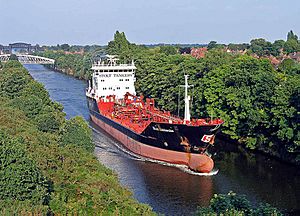
By the 1850s, Manchester had grown into a huge industrial city. This rapid growth put a lot of pressure on the city's services, like water supply and transport. Engineers had to find new ways to provide enough water for everyone.
In the 1840s, it was decided that Manchester needed more water. John Frederick Bateman suggested building a series of six reservoirs in the Longdendale Valley to the east of Manchester. Later, from 1890 to 1925, the Thirlmere Aqueduct was built to bring even more water from Thirlmere to Manchester.
The Manchester Ship Canal
In the 1880s, people started planning a new Manchester Ship Canal. Daniel Adamson, a Manchester manufacturer, led this idea. The canal would allow large ships to sail directly into Manchester, even though the city is far from the sea.
The Manchester Ship Canal opened in 1894 and was briefly the longest ship canal in the world. At its busiest in the 1960s, it was the third busiest port in Britain! This amazing engineering feat helped Manchester become an even more important city.
Trafford Park: The First Industrial Estate
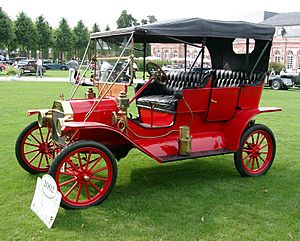
After the Ship Canal opened in 1894, plans began for a new industrial area called Trafford Park. This was the first industrial estate of its kind in the world! It was built on land bought from Sir Humphrey Francis de Trafford.
Marshall Stevens helped develop Trafford Park into a huge success. Within five years, it was home to forty companies. It became Europe's largest industrial estate. Big companies like Ford and Kellogg's set up factories there. Trafford Park was also home to the first Ford factory outside the United States, where they built the famous Ford Model T car.
During World War II, Trafford Park became vital for making military equipment. Ford's factory there was converted to produce Rolls-Royce Merlin engines, which powered many British aircraft like the Supermarine Spitfire and the Avro Lancaster. The factory was incredibly efficient, greatly reducing the time and cost to build each engine. Over 30,000 Merlin engines were produced there, with almost no rejections!
Today, the Ship Canal is not as busy as it once was, but Trafford Park remains Europe's largest industrial estate.
20th Century Innovations
The 'Nuclear Family' of Scientists
In the late 1800s and early 1900s, Manchester became famous for its work in nuclear physics. A group of scientists, nicknamed the 'Nuclear Family', made huge discoveries here. This 'family' included J. J. Thomson, Ernest Rutherford, Niels Bohr, and James Chadwick.
J. J. Thomson, born in Manchester, discovered the electron in 1897 and also isotopes. He won the Nobel Prize in Physics in 1906. Thomson also invented the mass spectrometer.
In 1907, Ernest Rutherford, who had been taught by Thomson, moved to Manchester. Rutherford is often called the 'father of nuclear physics'. In 1917, he successfully 'split the atom', a groundbreaking achievement. His work influenced many students, including James Chadwick, who later discovered the neutron.
Aviation Pioneers
[[Multiple image|direction=horizontal|align=left|image1=Avro Lancaster B I PA474.jpg|image2=Avro Vulcan Bomber RAF.JPEG|width=150|caption1=The Lancaster and Vulcan were both designed by Avro near Manchester.|caption2= The Lancaster was also an improved version of the Avro Manchester.|alt1=Lancaster|alt2=Vulcan]] Manchester has been home to important aviation companies, especially Avro. In 1910, French pilot Louis Paulhan flew from London to Manchester in about 12 hours, winning a prize.
John Alcock, born in Old Trafford, Manchester, became a skilled pilot. After World War I, he wanted to be the first to fly non-stop across the Atlantic Ocean. On June 14, 1919, Alcock and Arthur Whitten Brown took off from Newfoundland. They landed in Ireland 16 hours and 12 minutes later, flying 1,980 miles! Their flight in a modified Vickers Vimy bomber won them a £10,000 prize.
In 1910, Alliott Verdon Roe founded Avro in Manchester. With designer Roy Chadwick, Avro created famous British aircraft. The Avro Lancaster bomber, used in World War II, was an improved version of the Avro Manchester and became one of the most important British aircraft of the war.
Astronomy at Jodrell Bank
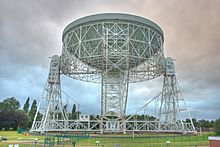
In the 1930s, astronomer Bernard Lovell came to Manchester. After World War II, he wanted to build a large radio telescope away from the city's light and radio interference. He found the perfect spot in the Cheshire Plain, south of Manchester, at the Jodrell Bank Observatory.
With funding, an 89-meter tall telescope was built. When it became operational in 1957, it was the largest telescope in the world! It was ready just before the launch of Sputnik 1, the world's first artificial satellite. The Lovell Telescope was the only one that could track Sputnik's booster rocket by radar. It also tracked Sputnik 2 and other early satellites. Jodrell Bank Observatory is now run by the University of Manchester and is a UNESCO World Heritage Site.
The First Stored-Program Computer
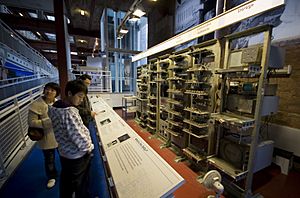
In 1946, Frederic Calland Williams and Tom Kilburn at the Victoria University of Manchester worked on a breakthrough. They created the Williams tube, which could store digital information. This led to the creation of the Manchester Baby, the world's first electronic stored-program computer. It was switched on on June 21, 1948.
Even though it was simple compared to today's computers, the Manchester Baby was a huge step forward. It proved that computers could store and run programs. Later, with Alan Turing joining the team, they developed the Manchester Mark 1, a more practical computer. This work led to many patents and advancements in computer science.
The First Test-Tube Baby
In 1978, after ten years of research by Manchester-born Robert G. Edwards and his colleague Patrick Steptoe, the world's first baby conceived by in vitro fertilisation (IVF) was born. Her name was Louise Brown. She was born at Oldham General Hospital on July 25, 1978.
This was a major medical breakthrough, offering a new way for couples who couldn't have children naturally to start a family. By 2010, about 4 million children had been born through IVF. In 2010, Robert G. Edwards won the Nobel Prize in Physiology or Medicine for his work on IVF.
21st Century Discoveries
Graphene: The 'Miracle Material'
In 2010, Andre Geim and Konstantin Novoselov, physicists at the University of Manchester, won the Nobel Prize in Physics. They won for their work on graphene, a super-strong and super-thin material. They successfully isolated it in 2004.
Scientists are still researching graphene today to find many practical uses for this 'miracle material'. In 2011, the British government announced £50 million in funding to help develop graphene further in the United Kingdom.
See also


